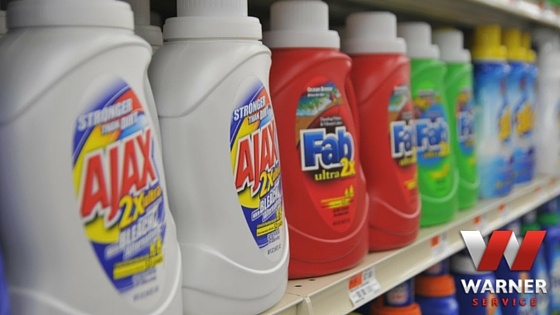
When you spend your lunch hour buzzing through the grocery store, you’ll probably pick up items without really looking at their ingredients. Some people prefer name-brand items while others go for what's on sale. However, because you decide what goes in your cart, you should always take a good look at what's inside your cleaning products. To make sure your family stays safe, the environment is taken care of and your house remains in tip-top shape, here’s Warner Service’s list of some chemicals you should absolutely avoid:
Ammonia: This chemical is one of the most common in household products. It’s mainly in polishing agents for bathroom fixtures, sinks, glass and jewelry. Even though it’s found in everyday products, ammonia can have terrible affects on your health, especially for those with pre-existing lung issues and breathing problems, like asthma and chronic bronchitis.
The healthier choice? Vodka or toothpaste. (Yes, we’re serious.)
Chlorine: This chemical is in scouring powders for your bathtub and shower, toilet bowl cleaners, mildew removers, laundry whiteners/bleach products and household tap water. Chlorine is a respiratory and skin irritant and thyroid disrupter. Health cases can range from acture to chronic, but it's best not to take a chance.
The healthier option? Baking soda, vinegar, and water filters.
Perchloroethylene (Perc): This chemical is found in many spot removers for your clothes, carpet and upholstery. Perc is classified as a neurotoxin. (Yikes.) It can have carcinogenic effects on your health, including dizziness, loss of coordination, mild memory loss, loss of visual perception, slower reaction time, redness and blistering. (Bigger yikes.)
The healthier choice? Undiluted castile soap.
Sodium hydroxide: This chemical is also known as caustic soda, lye or sulfuric acid. It’s found in most off-the-shelf, name-brand drain cleaners, and unfortunately, it’s terrible for your home’s pipes, your health and the environment. Here’s why:
- It’ll clear a clog of organic material quickly, but sodium hydroxide is extremely corrosive to many metals. Talk about counterproductive.
- It can burn through your clothes and skin because it’s made to eat away at anything in its path.
- The packaging can’t be recycled because of the caustic chemicals. Any chemical drain cleaner with sodium hydroxide poured down the drain makes its way to bodies of water and harms wildlife.
- If sodium hydroxide is mixed with other household cleaners, it's game over. It can produce an explosion or toxic gas.
The healthier option? Check out any of these methods.
Quarternary Ammonium Compounds (Quats): This chemical is found in fabric softener liquid and sheets as well as most household cleaners labeled “antibacterial.” Though the concept of destroying bacteria is a good theory, it comes with a major repercussion: the development of antibiotic-resistant bacteria, also known as antimicrobials. These are a leading cause of skin irritation, respiratory disorders, and endocrine disruption.
The healthier choice? White vinegar, tea-tree oil, and a drop of lavender.
These 5 chemicals are found in most household cleaners, but, unfortunately, there are many more that can harm your health, your home and the environment. To make sure you avoid all of the harsh chemicals possible, take a look at Environmental Working Group’s Hall of Shame, a comprehensive guide to all cleaning products you should avoid bringing into your home.
Even with the safest cleaning products, your home could still use a little TLC before the spring. Feel feel to contact us today for a maintenance check-up.


